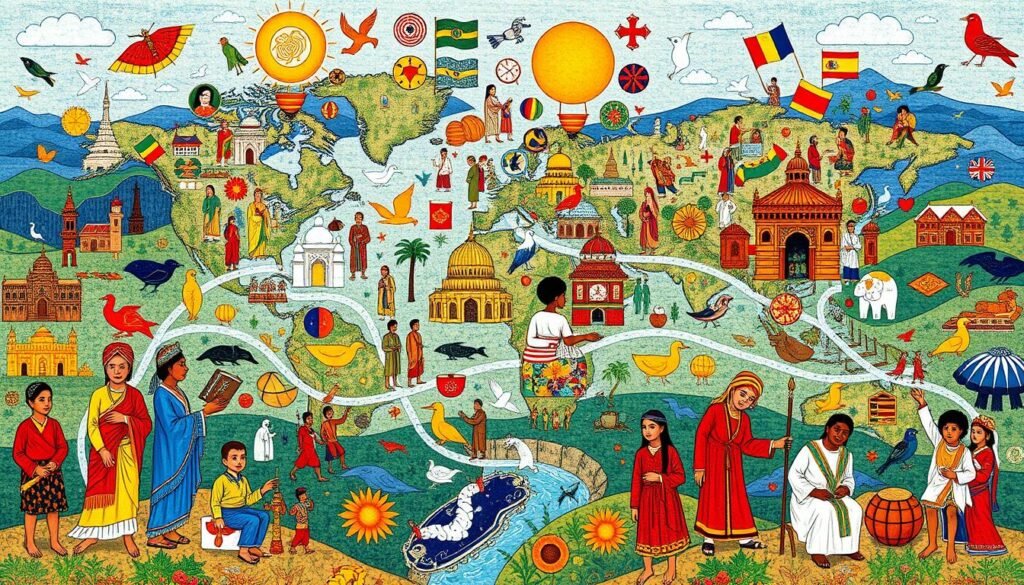Your Topics, Multiple Stories: A Rich Tapestry of Narratives

Did you know the average person tells about 20,000 stories in their life? This shows how important storytelling is to us. By looking at different stories, we see a wide range of human experiences.
Each story has its own power, giving us new views and making our lives richer. By seeing things from many angles, we learn more and connect with others. This article will explore why stories matter and how they shape who we are.
The Power of Diverse Narratives
Diverse stories are key to understanding different cultures. They help us see the world from new angles. This way, we learn to appreciate and empathize with others’ lives.
Exploring a wide range of cultural tales changes how we think and feel. It shapes our beliefs and values in big ways.
Understanding Different Perspectives
Every story comes from a unique place and experience. They show us the rich tapestry of human life. By reading diverse stories, we gain valuable insights.
We learn about communities often overlooked. This broadens our understanding and challenges our assumptions about others.
How Stories Shape Our Culture
Stories are like threads in our society’s fabric. They influence our traditions, norms, and values. They help us understand who we are.
Through stories, we learn how to interact with our communities. They affect education, politics, and social movements. Valuing diverse stories leads to a fairer world.

Your Topics, Multiple Stories
Storytelling connects us and shares experiences from different backgrounds. It helps us understand the many sides of human life. This leads to deeper conversations and new insights. We’ll look at the variety of storytelling themes and their impact across disciplines.
Exploring Various Themes
Storytelling covers personal stories, cultural histories, and today’s social issues. Each theme offers a special way to see life’s complexities. By exploring these themes, storytellers help us understand the importance of our topics in society.
- Personal Growth: Insights from emotional journeys that resonate with the audience.
- Cultural Narratives: Stories that reflect heritage and communal values.
- Social Commentary: Engaging with current issues and diverse perspectives.
The Impact of Storytelling Across Disciplines
Storytelling goes beyond school subjects, touching psychology, education, and literature. It makes complex information easier to grasp and connect with. By mixing different themes, experts craft stories that capture the interest of many.

The Interconnection of Stories
Stories create complex webs of experiences that touch many people. They share common themes that connect us all, no matter where we come from. This connection makes stories important in our daily lives.
Common Threads in Unique Narratives
Looking at common story themes shows us what we all share. Many stories focus on:
- Struggle and Triumph: They tell of the battles and victories in people’s lives.
- Community and Belonging: They show how important our relationships are, bringing us together.
- Personal Growth: They follow characters as they change and grow.
These stories help us see ourselves in others. They build empathy and understanding across different groups.
Finding Relevance in Everyday Life
Our everyday lives are shaped by stories that reflect our experiences. Whether in books, movies, or personal stories, these tales have a big impact. They help us connect with others’ struggles and successes.
When we hear stories, we use what we learn to see the world differently. This makes stories powerful and meaningful in our lives.
Creating Emotional Resonance
Emotional storytelling is key to great stories. It turns simple tales into deep connections, linking the storyteller and the audience. Stories can stir strong feelings, leaving a mark that goes beyond just sharing facts.
Connecting through Shared Experiences
Shared experiences are the base of emotional connection. When stories mirror our lives, we feel a deeper bond. These moments of recognition help us connect, sharing our own feelings and memories. Examples include:
- Life-changing events
- Struggles and triumphs
- Universal emotions like love and loss
Emotional Engagement in Storytelling
Engagement in stories comes from feeling emotionally involved. Using psychology, stories that touch our hearts make us care more. This emotional tie boosts our interest and understanding. The power of storytelling lies in its ability to make us feel something. Ways to improve emotional storytelling include:
- Creating characters we can relate to
- Using vivid images to paint a picture in our minds
- Adding themes and conflicts we can identify with
Multimedia as a Storytelling Tool
In today’s digital world, multimedia storytelling changes how we tell stories. It combines different types of content, like images and sounds, to create deep experiences. This way, stories grab our attention and touch our hearts more.
Enhancing Narratives with Visuals and Audio
Visuals are key in keeping our interest. Infographics, pictures, and videos make complex ideas simple and fast. When paired with sounds, they make stories richer and more emotional.
Podcasts or soundscapes add layers to stories. They bring out feelings and moods that make the message stronger.
The Role of Social Media in Modern Narratives
Social media is now a big part of sharing stories worldwide. Sites like Instagram and TikTok let people mix visuals and sounds in new ways. This makes it easy for anyone to share their stories and connect with others.
Stories on social media reach more people. They help build communities and understanding among different groups.
Case Studies: Compelling Real-Life Stories
Real-life stories are powerful. They show the impact of storytelling. People share their experiences, touching hearts and minds.
These stories are not just about individual journeys. They help us understand and connect with others. They show how stories can unite us.
Impactful Personal Journeys
Many case studies focus on personal stories. These stories can change how we see the world. They inspire us to take action.
The “Humans of New York” project is a great example. It lets people share their lives. Each story teaches us about different experiences, promoting empathy.
Notable Examples of Diverse Narratives
“The Moth” is a place where stories come alive. It lets people share their experiences on stage. This shows how stories can reflect our society.
Research from the Community Psychology Journal supports this. It shows how stories help build communities. They help us feel connected and strong.
Crafting Your Own Narrative
Every person has a unique story to tell. This makes creating your own narrative very personal. Finding your voice in stories makes it richer. It’s about knowing what touches your audience.
This section will look at ways to make your stories engaging.
Finding Your Voice
Your unique voice is what makes your story special. Being true to yourself is key to grabbing attention and connecting with others. Here are some tips:
- Embrace your experiences: Let your personal insights shape your stories.
- Be true to your style: Try different ways of writing until you find what feels natural.
- Listen to feedback: Talk to your readers to make your voice even clearer.
Techniques for Effective Storytelling
Using the right storytelling techniques can make your stories better. Here are some tips:
- Show, don’t tell: Show emotions through actions and words, so readers can feel it.
- Use vivid imagery: Add sensory details to pull your audience into the story.
- Engage with conflict: Conflicts are what drive stories. Create challenges that test your characters.
The Importance of Audience Engagement
Engaging an audience is more than just telling a story. It’s about understanding what connects with different groups. Tailoring stories makes sure they resonate with specific people, sparking real interest.
Tailoring Stories for Different Audiences
Creating stories for specific groups creates a deeper bond. Knowing what each group values helps storytellers connect better. This approach makes stories that grab attention, make us think, and feel, starting meaningful conversations.
Building a Community Through Shared Narratives
Storytelling brings people together through shared experiences. By telling stories that show our collective journey, we build a strong bond. These stories help us feel part of something bigger, encouraging us to engage more and connect with others.
Conclusion
In this summary, we explored how diverse stories enrich our understanding and help us connect with others. We looked at the importance of different themes, emotional connections, and engaging with our audience. By sharing many stories, we gain new insights and build stronger bonds with each other.
This overview shows that everyone has a unique story to tell. These stories can light up our experiences and connect us across different backgrounds. As we finish this journey, it’s clear that our personal stories are key to empathy and connection.
Storytelling is more than just an art; it’s a powerful way to communicate and understand each other. We encourage you to find your voice and share your story. Through storytelling, we can change lives, fostering meaningful conversations and building communities.


